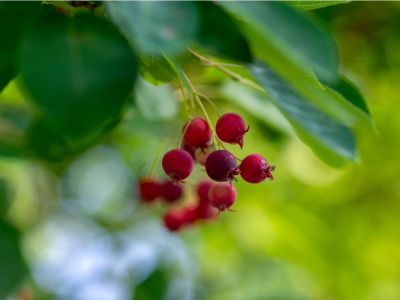What is a Serviceberry?
Serviceberries are trees or bushes, depending on cultivar, with a beautiful natural shape and edible fruit. While all serviceberry fruit is edible, the tastiest fruit is found on the Saskatoon variety. A member of the genus Amelanchier, serviceberries reward homeowners with a spectacular display of showy white flowers that look like lilacs in the spring, attractive fall foliage, and pretty gray bark. Reaching from 6 to 20 feet (2-6 m.) or more at maturity, serviceberries grow in United States Department of Agriculture (USDA) growing zones 2 through 9.
Growing Serviceberry Trees
Serviceberries are not overly sensitive to soil type but prefer a pH of 6.0 to 7.8. They also perform best in soil that is lighter and not loaded with clay, as this prevents adequate drainage. Although they will grow well in both part shade and full sun, planting in full sun is recommended if you want the best tasting and largest harvest of fruit. Plant trees 9 feet (2.5 m.) apart as a hedgerow for serviceberry fruit production. Nets are often used to protect fruit from hungry birds.
Care of Serviceberries
Serviceberries enjoy just enough water to keep the soil moist but not saturated. Irrigate when the top 3 or 4 inches (8-10 cm.) of soil feels dry. Care of serviceberries planted in sandy soils requires more frequent watering, as it drains quicker than loamy soil. Trees planted in humid climates will require less water than those in dry climates. Place a 2 inch (5 cm.) layer of mulch around the plant to help with moisture retention and to add a decorative effect. Do not allow the mulch to touch the trunk of the tree. The best time to apply mulch is in the early spring. Organic fertilizer applied around the drip line in six week intervals during the growing season will keep growing serviceberry trees looking their best. The serviceberry is in the rose family so it can suffer from the same type of problems as roses do. Be on the lookout for Japanese beetles, spider mites, aphids, and leaf miners, as well as borers. Powdery mildew, rust, and leaf spot may also occur. To avoid serious problems with insects and disease, keep your serviceberry as healthy as possible.
Pruning Serviceberry Trees and Shrubs
Serviceberries require pruning yearly; late winter or early spring is best before the new leaves appear. Inspect the tree for deadwood, diseased wood, and crossed branches. Use clean and sharp pruners to remove just what is necessary. Leaving some old growth is important, as the flowers form on old wood. Be sure to dispose of infected limbs properly; don’t put them in the compost pile.
